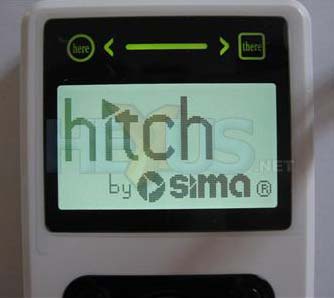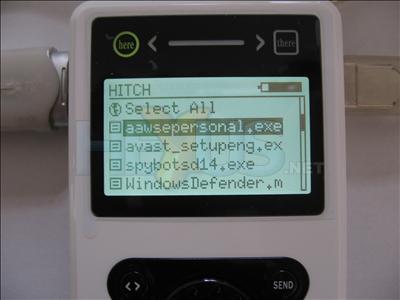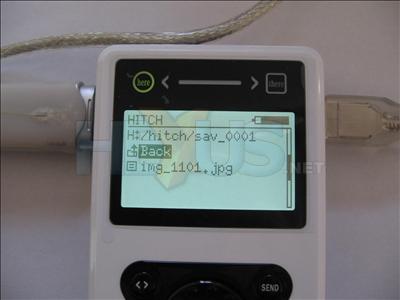Usage
Usage
Turn on Hitch and the it'll take a few seconds for its Linux kernel and embedded software to get up and running.
While booting, a Hitch/Sima logo is displayed on the monochrome LCD display.
The 'about' page reveals the software version we were running. At the time of writing no firmware updates were available.
Connect up a USB device and within a few seconds it should be recognised and read from. The left USB port is 'here' and the right USB port 'there'. The 'here' and 'there' concept is used throughout the software to distinguish between the two attached devices.
In the above picture, a 32MiB USB1.1 flash drive is connected 'here', with a Canon PowerShot A520 hooked up 'there'.
With devices connected, Hitch will show directory listings. Navigation is done through the scroll wheel and middle select wheel, similar to an iPod. The '< >' button switches from viewing from one device to the other, the display atop Hitch indicating which device is being viewed.
Basic file information can be displayed by selecting a file. Transferring a file simply requires that you scroll to it in the directory listing and hit the 'send' button. The file will then be transferred to the other device. A tick appears next to all files that have been copied in a session.
By default, Hitch will create a 'Hitch' subfolder on the target device then create a 'sav_xxxx' folder, where the 'x's are a number incremented with each session. This can be changed by switching to the target device and holding the select button down to get access to the settings screen. The current folder can then be chosen as the target.
When one or more iPods want in on the action, Hitch can be put into 'music mode'. In this mode, it's able to read the iPod's music database and list the tracks in it. Music can then be copied from or to an iPod. Files can be transferred by song, album or artist. The Hitch manual provides details on how to synchronise the iPod's updated library with iTunes. Doing this seems a little on the cumbersome side, but it will be necessary in some cases, when copy-protected files are being 'shared' and authorisation is required.
This reviewer isn't trendy enough to have an iPod, let alone two, so we couldn't test this aspect of Hitch. Sufficient to say, much of the manual covers iPods, so support for the media player wasn't an afterthought of Sima; it's an integral part of the Hitch USB-101's design. The biggest caveat to iPod support is that the iPod's disk must be FAT formatted. It will already be so if used with Windows iTunes, but maybe not for Mac users.
Device and transfer support
During our testing, we tried a few devices to see whether Hitch could handle them. We hooked up a 40GB IBM 2.5" hard drive, in a 2.5 Ultra USB enclosure, but found it was unable to complete its spin-up process. We can only assume that it wasn't getting enough current, seeing as it runs fine off a PC's USB port. This contradicts Hitch's specifications, which say it can give out the full 500mA on both ports simultaneously. We surmised that the battery might have needed fully charging, but even once we got a USA to UK adapter for the power pack, it wouldn't spin up the drive, running off the mains. Of course, it might be that the enclosure draws slightly more than 500mA and the PC's ports were a little more lenient on over-current.
We moved on to a 3.5" Icy Box USB disk enclosure, which was externally powered, containing a 200GB Maxtor IDE hard drive. It was initially formatted as NTFS, but we created a FAT32 partition for testing with Hitch; NTFS isn't a supported filesystem. However, when we hooked up Hitch to the drive, the drive clicked and span itself down. Plugging it into a PC would make it spin up again. The Icy Box in question is somewhat picky about the devices it'll connect with amicably, in our experience, so we can't blame Hitch for this one, especially seeing as the Icy Box shouldn't have needed to draw much power from Hitch.
That left us with a USB thumb drive and a Canon PowerShot A520; those we initially connected up to Hitch. The PowerShot uses PTP, not mass storage. Hitch read its picture database without any issues, but PTP did limit us to read-only interaction with the PowerShot. The thumb drive, operating as mass storage, was both readable and writeable, though.














